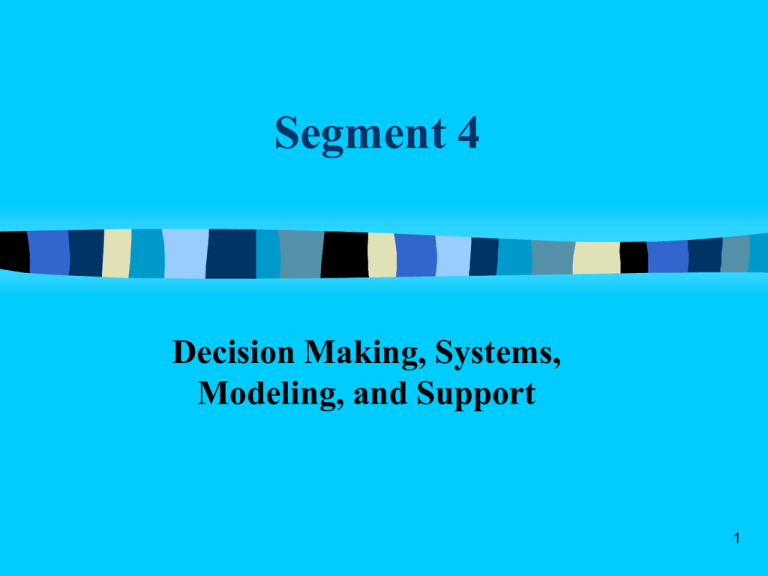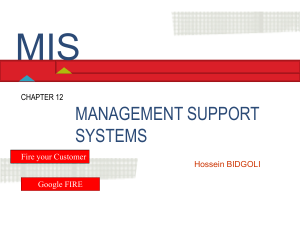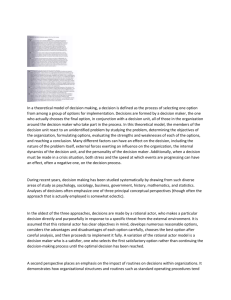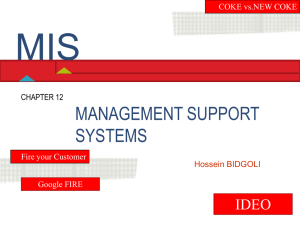Chapter 2: Decision Making, Systems, Modeling, and Support
advertisement

Segment 4 Decision Making, Systems, Modeling, and Support 1 Decision Making, Systems, Modeling, and Support Conceptual Foundations of Decision Making The Systems Approach How Support is Provided 2 Typical Decision Aspects Decision may be made by a group Group member biases Groupthink Several, possibly contradictory objectives Many alternatives Results can occur in the future Attitudes towards risk Need information Gathering information takes time and expense Too much information “What-if” scenarios Trial-and-error experimentation with the real system may result in a loss Experimentation with the real system - only once Changes in the environment can occur continuously Time pressure 3 How are decisions made??? What methodologies can be applied? What is the role of information systems in supporting decision making? DSS Decision Support Systems 4 , Decision Making Decision Making: a process of choosing among alternative courses of action for the purpose of attaining a goal or goals Managerial Decision Making is synonymous with the whole process of management 5 System Environment Output(s) Input(s) Processes Feedback Boundary 6 Environmental Elements Can Be Social Political Legal Physical Economical Often Other Systems 7 An Information System Collects, processes, stores, analyzes, and disseminates information for a specific purpose Is often at the heart of many organizations Accepts inputs and processes data to provide information to decision makers and helps decision makers communicate their results 8 System Effectiveness and Efficiency Two Major Classes of Performance Measurement Effectiveness is the degree to which goals are achieved Doing the right thing! Efficiency is a measure of the use of inputs (or resources) to achieve outputs Doing the thing right! MSS emphasize effectiveness Often: several non-quantifiable, conflicting goals 9 Models Major component of DSS Use models instead of experimenting on the real system A model is a simplified representation or abstraction of reality. Reality is generally too complex to copy exactly Much of the complexity is actually irrelevant in problem solving 10 Degrees of Model Abstraction (Least to Most) Iconic (Scale) Model: Physical replica of a system Analog Model behaves like the real system but does not look like it (symbolic representation) Mathematical (Quantitative) Models use mathematical relationships to represent complexity Used in most DSS analyses 11 Benefits of Models 1. Time compression 2. Easy model manipulation 3. Low cost of construction 4. Low cost of execution (especially that of errors) 5. Can model risk and uncertainty 6. Can model large and extremely complex systems with possibly infinite solutions 7. Enhance and reinforce learning, and enhance training. Computer graphics advances: more iconic and analog models (visual simulation) 12 The Modeling Process-A Preview How Much to Order for the Ma-Pa Grocery? Bob and Jan: How much bread to stock each day? Solution Approaches Trial-and-Error Simulation Optimization Heuristics 13 Problem Decomposition: Divide a complex problem into (easier to solve) subproblems Chunking (Salami) Some seemingly poorly structured problems may have some highly structured subproblems Problem Ownership Outcome: Problem Statement 14 The Design Phase Generating, developing, and analyzing possible courses of action Includes Understanding the problem Testing solutions for feasibility A model is constructed, tested, and validated Modeling Conceptualization of the problem Abstraction to quantitative and/or qualitative forms 15 Mathematical Model Identify variables Establish equations describing their relationships Simplifications through assumptions Balance model simplification and the accurate representation of reality Modeling: an art and science 16 Quantitative Modeling Topics Model Components Model Structure Selection of a Principle of Choice (Criteria for Evaluation) Developing (Generating) Alternatives Predicting Outcomes Measuring Outcomes Scenarios 17 Components of Quantitative Models Decision Variables Uncontrollable Variables (and/or Parameters) Result (Outcome) Variables Mathematical Relationships or Symbolic or Qualitative Relationships 18 Results of Decisions are Determined by the Decision Uncontrollable Factors Relationships among Variables 19 Result Variables Reflect the level of effectiveness of the system Dependent variables 20 Decision Variables Describe alternative courses of action The decision maker controls them 21 Uncontrollable Variables or Parameters Factors that affect the result variables Not under the control of the decision maker Generally part of the environment Some constrain the decision maker and are called constraints Intermediate Result Variables Reflect intermediate outcomes 22 The Structure of Quantitative Models Mathematical expressions (e.g., equations or inequalities) connect the components Simple financial model P=R - C Present-value model P = F / (1+i)n 23 Selection of a Principle of Choice Not the choice phase A decision regarding the acceptability of a solution approach Normative Descriptive 24 Normative Models The chosen alternative is demonstrably the best of all (normally a good idea) Optimization process Normative decision theory based on rational decision makers 25 Rationality Assumptions Humans are economic beings whose objective is to maximize the attainment of goals; that is, the decision maker is rational In a given decision situation, all viable alternative courses of action and their consequences, or at least the probability and the values of the consequences, are known Decision makers have an order or preference that enables them to rank the desirability of all consequences of the analysis 26 Suboptimization Narrow the boundaries of a system Consider a part of a complete system Leads to (possibly very good, but) non-optimal solutions Viable method 27 Descriptive Models Describe things as they are, or as they are believed to be Extremely useful in DSS for evaluating the consequences of decisions and scenarios No guarantee a solution is optimal Often a solution will be good enough Simulation: Descriptive modeling technique 28 Descriptive Models Information flow Scenario analysis Financial planning Complex inventory decisions Markov analysis (predictions) Environmental impact analysis Simulation Waiting line (queue) management 29 Satisficing (Good Enough) Most human decision makers will settle for a good enough solution Tradeoff: time and cost of searching for an optimum versus the value of obtaining one Good enough or satisficing solution may meet a certain goal level is attained 30 Why Satisfice? Bounded Rationality Humans have a limited capacity for rational thinking Generally construct and analyze a simplified model Behavior to the simplified model may be rational But, the rational solution to the simplified model may NOT BE rational in the real-world situation Rationality is bounded by – limitations on human processing capacities – individual differences Bounded rationality: why many models are descriptive, not normative 31 Developing (Generating) Alternatives In Optimization Models: Automatically by the Model! Not Always So! Issue: When to Stop? 32 Predicting the Outcome of Each Alternative Must predict the future outcome of each proposed alternative Consider what the decision maker knows (or believes) about the forecasted results Classify Each Situation as Under – Certainty – Risk – Uncertainty 33 Decision Making Under Certainty Assumes complete knowledge available (deterministic environment) Example: U.S. Treasury bill investment Typically for structured problems with short time horizons Sometimes DSS approach is needed for certainty situations 34 Decision Making Under Risk (Risk Analysis) Probabilistic or stochastic decision situation Must consider several possible outcomes for each alternative, each with a probability Long-run probabilities of the occurrences of the given outcomes are assumed known or estimated Assess the (calculated) degree of risk associated with each alternative 35 Risk Analysis Calculate the expected value of each alternative Select the alternative with the best expected value Example: poker game with some cards face up (7 card game - 2 down, 4 up, 1 down) 36 Decision Making Under Uncertainty Several outcomes possible for each course of action BUT the decision maker does not know, or cannot estimate the probability of occurrence More difficult - insufficient information Assessing the decision maker's (and/or the organizational) attitude toward risk Example: poker game with no cards face up (5 card stud or draw) 37 Measuring Outcomes Goal attainment Maximize profit Minimize cost Customer satisfaction level (minimize number of complaints) Maximize quality or satisfaction ratings (surveys) 38 Scenarios Useful in Simulation What-if analysis 39 Importance of Scenarios in MSS Help identify potential opportunities and/or problem areas Provide flexibility in planning Identify leading edges of changes that management should monitor Help validate major assumptions used in modeling Help check the sensitivity of proposed solutions to changes in scenarios 40 Decision Possible Scenarios Worst possible (low demand, high cost) Best possible (high demand, high revenue, low cost) Most likely (median or average values) Many more The scenario sets the stage for the analysis 41 The Choice Phase The CRITICAL act - decision made here! Search, evaluation, and recommending an appropriate solution to the model Specific set of values for the decision variables in a selected alternative The problem is considered solved only after the recommended solution to the model is successfully implemented 42 Search Approaches Analytical Techniques Algorithms (Optimization) Blind and Heuristic Search Techniques 43 Evaluation: Multiple Goals, Sensitivity Analysis, What-If, and Goal Seeking Evaluation (with the search process) leads to a recommended solution Multiple goals Complex systems have multiple goals Some may conflict Typically, quantitative models have a single goal Can transform a multiple-goal problem into a single-goal problem 44 Common Methods Utility theory Goal programming Expression of goals as constraints, using linear programming Point system Computerized models can support multiple goal decision making 45 Sensitivity Analysis Change inputs or parameters, look at model results Sensitivity analysis checks relationships Types of Sensitivity Analyses Automatic Trial and error 46 Trial and Error Change input data and re-solve the problem Better and better solutions can be discovered How to do? Easy in spreadsheets (Excel) – What-if – Goal seeking 47 What-If Analysis Spreadsheet example of a what-if query for a staffing problem 48 Goal Seeking Backward solution approach Example: What interest rate causes an the net present value of an investment to break even? In a DSS the what-if and the goal-seeking options must be easy to perform 49 The Implementation Phase There is nothing more difficult to carry out, nor more doubtful of success, nor more dangerous to handle, than to initiate a new order of things (Machiavelli, 1500s) *** The Introduction of a Change *** Important Issues Resistance to change Degree of top management support Users’ roles and involvement in system development Users’ training 50 Alternative Decision Making Models Paterson decision-making process Kotter’s process model Pound’s flow chart of managerial behavior Kepner-Tregoe rational decision-making approach Hammond, Kenney, and Raiffa smart choice method Cougar’s creative problem solving concept and model Pokras problem-solving methodology Bazerman’s anatomy of a decision Harrison’s interdisciplinary approaches Beach’s naturalistic decision theories 51 Naturalistic Decision Theories Focus on how decisions are made, not how they should be made Based on behavioral decision theory Recognition models Narrative-based models 52 Recognition Models Policy Recognition-primed decision model 53 Narrative-based Models (Descriptive) Scenario model Story model Argument-driven action (ADA) model Incremental models Image theory 54 Other Important DecisionMaking Issues Personality types Gender Human cognition Decision styles 55 Cognition Cognition: Activities by which an individual resolves differences between an internalized view of the environment and what actually exists in that same environment Ability to perceive and understand information Cognitive models are attempts to explain or understand various human cognitive processes 56 Cognitive Style The subjective process through which individuals perceive, organize, and change information during the decision-making process Often determines people's preference for human-machine interface Impacts on preferences for qualitative versus quantitative analysis and preferences for decision-making aids Affects the way a decision maker frames a problem 57 Cognitive Style Research Impacts on the design of management information systems May be overemphasized Analytic decision maker Heuristic decision maker 58 Decision Styles The manner in which decision makers Think and react to problems Perceive their – Cognitive response – Values and beliefs Varies from individual to individual and from situation to situation Decision making is a nonlinear process The manner in which managers make decisions (and the way they interact with other people) describes their decision style There are dozens 59 Some Decision Styles Heuristic Analytic Autocratic Democratic Consultative (with individuals or groups) Combinations and variations For successful decision-making support, an MSS must fit the – Decision situation – Decision style 60 The system – – – – should be flexible and adaptable to different users have what-if and goal seeking have graphics have process flexibility An MSS should help decision makers use and develop their own styles, skills, and knowledge Different decision styles require different types of support Major factor: individual or group decision maker 61 The Decision Makers Individuals Groups 62 Individuals May still have conflicting objectives Decisions may be fully automated 63 Groups Most major decisions made by groups Conflicting objectives are common Variable size People from different departments People from different organizations The group decision-making process can be very complicated Consider Group Support Systems (GSS) Organizational DSS can help in enterprise-wide decision-making situations 64 Summary Managerial decision making is the whole process of management Problem solving also refers to opportunity's evaluation A system is a collection of objects such as people, resources, concepts, and procedures intended to perform an identifiable function or to serve a goal DSS deals primarily with open systems A model is a simplified representation or abstraction of reality Models enable fast and inexpensive experimentation with systems 65 Modeling can employ optimization, heuristic, or simulation techniques Decision making involves four major phases: intelligence, design, choice, and implementation What-if and goal seeking are the two most common sensitivity analysis approaches Computers can support all phases of decision making by automating many required tasks Personality (temperament) influences decision making Gender impacts on decision making are inconclusive Human cognitive styles may influence human-machine interaction Human decision styles need to be recognized in designing MSS 66




